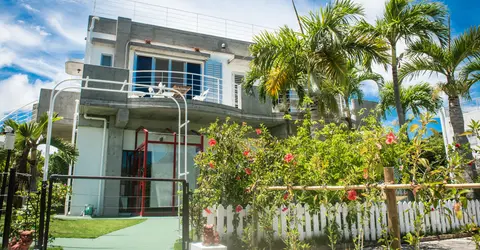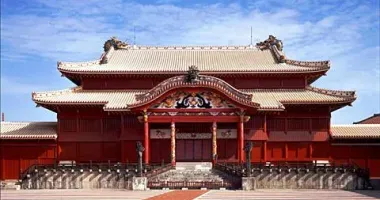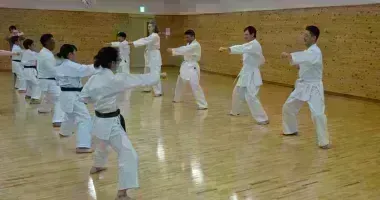Kudaka Island Okinawa
- Published on : 20/05/2019
- by : Japan Experience
- Youtube
Kudaka Island 久高島 off the coast of Okinawa main island is a sacred island. It is less than 4 kilometers long and a kilometer wide.
- Visiting Kudaka Island
- Noro Priestesses
- Kudaka Society
- Ishikihama Beach
- Tokujin Village
- Kudaka Island Cuisine
- Kudaka Access
Kudaka Island, Okinawa 久高島 沖縄
Johannes Schonherr
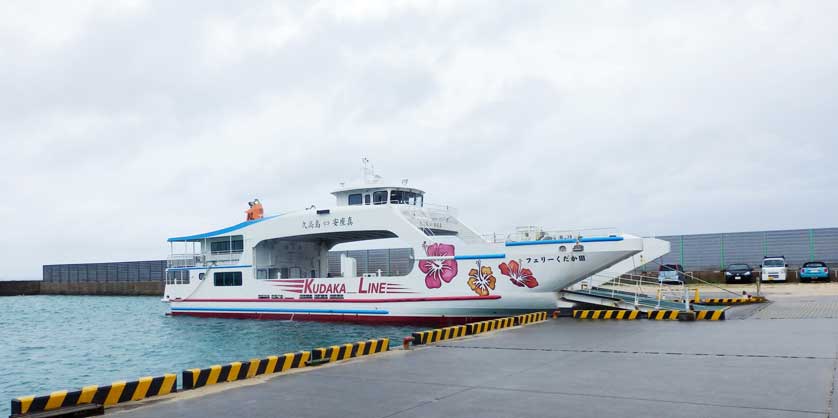
Kudaka Ferry at Azama Port, Okinawa
Kudaka Island, Kudaka-jima in Japanese, is a small island just a short ferry ride off the southeastern edge of the Okinawan mainland. It is less than 4 kilometers long and less than a kilometer wide.
Despite its tiny size, the island is tremendously important in Okinawan mythology. According to legend, Goddess Amamikiyo descended from heaven on this island. Starting from Kudaka, she created the whole Ryukyu Archipelago, stretching from the Amami Islands south of Kagoshima all the way down to the Yaeyama Islands close to Taiwan, with the Okinawan mainland in its center.
Thus, Kudaka is called the Island of the Gods. Numerous utaki dot the island, Okinawan sacred places, all of them closely related to the old gods of the native Okinawan Nirai Kanai religion.
In the times of the Ryukyu Kingdom (before Okinawa was annexed by Japan in 1879), the royal family residing at Shuri Castle near Naha made annual trips to Kudaka to refresh their spiritual powers.
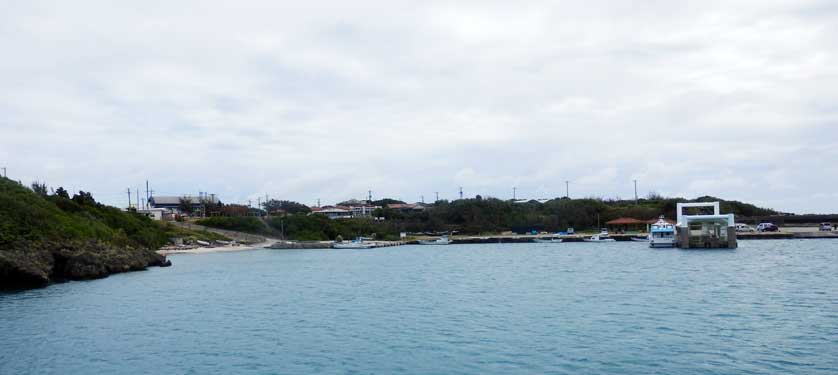
Approaching Tokujin Port, Kudaka Island
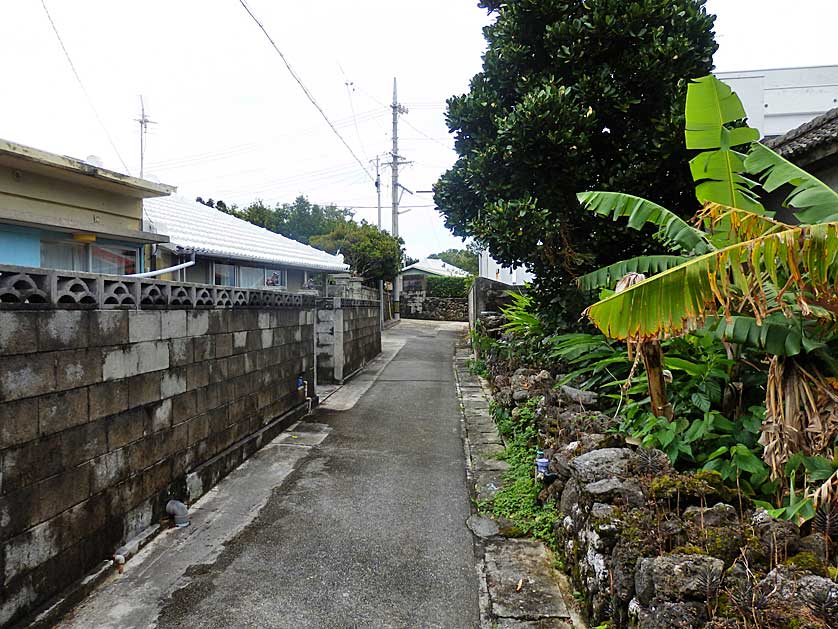
Typical street in Tokujin Village, Kudaka Island, Okinawa
Visiting Kudaka Island Today
The car ferry from Azama Port on the mainland takes 25 minutes to reach Tokujin Port, the only port on the island. The high-speed ferries cover the distance in just 15 minutes.
Yet, you arrive in a different world. The southern part of the Okinawan mainland is densely populated, the buildings tend to be made of concrete and are often outrageously garish.
You will see none of that on Kudaka Island. Tokujin Village, right next to the port, is a sleepy village of about 150 to 200 inhabitants. Virtually the whole population of the island concentrates in the village.
Walking from the port, you first reach the Kudaka Island Visitor Center which also serves as a souvenir shop and a waiting room for the ferry in case of rainy or stormy weather.
Many visitors rent bicycles right at the visitor center and start their exploration of the island on two wheels.
The visitor center offers a variety of free island maps in Japanese as well as in English.
Those maps point out the locations of the sacred utaki and tell which ancient god is associated with which utaki.
The most important information conveyed is, however, which utaki visitors are allowed to enter and which not.
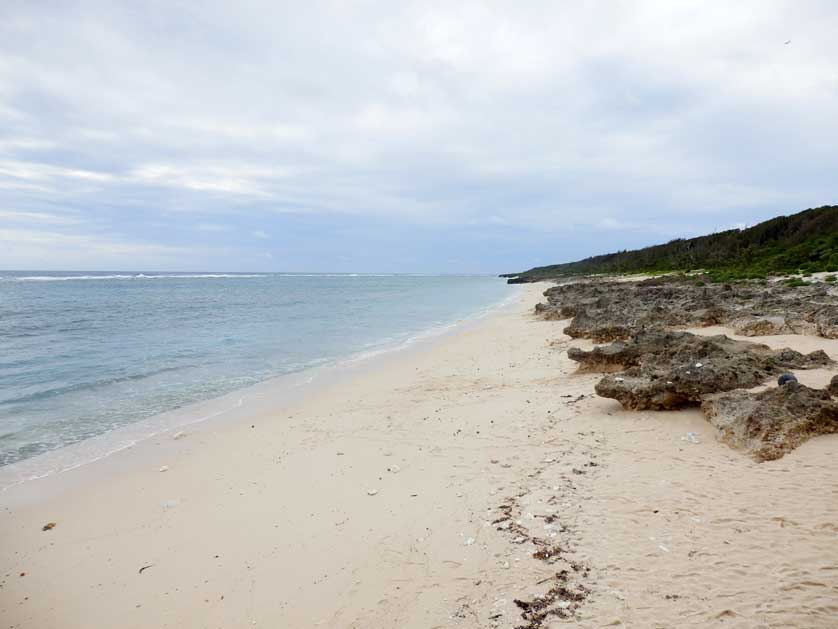
Beach, Kudaka Island, Okinawa
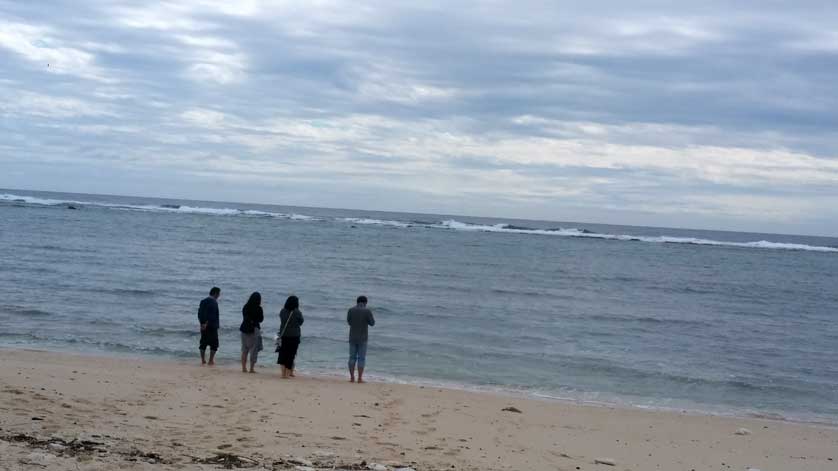
Sacred Kudaka Island - people praying at holy Ishikihama Beach
Noro Priestesses
Traditionally, only Noro priestesses, the priestesses of the Nirai Kanai religion, were able to access those holy spots to perform their ancient rituals.
Kudaka Noro priestesses need to be born on the island. It is debated if there are still any real Noro priestesses on the island. Today, island-born women take care of the utaki.
The most important island festival, the Izaiho Festival, taking place only every 12 years, always in the Year of the Horse, took place for the last time in 1978. It had to be canceled since due to a lack of island-born women schooled in the sacred rituals.
The population of the island is dwindling. Many young people are lured away by the bright lights of Naha, promising excitement and endless opportunities.

Sacred Ishikihama Beach, Kudaka Island, Okinawa
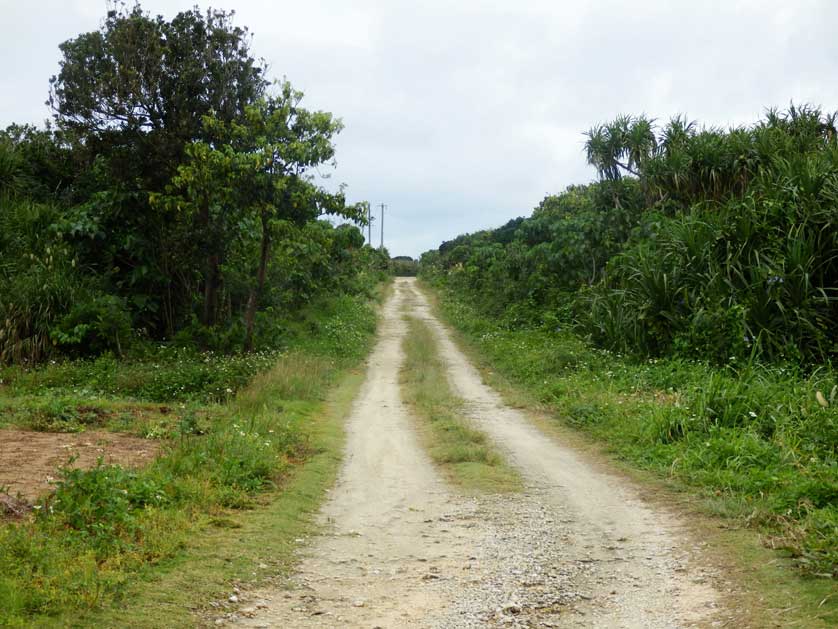
Typical road on Kudaka Island
Kudaka Society
Either on bicycle or by foot, most visitors head out of Tokujin Village on the so-called Akaribaru Michi, a road following the coastline a little inland towards Cape Kaberu where Goddess Amamikiyo first appeared. The road soon becomes unpaved.
Vegetable gardens line the road. Islanders tend them to provide for their own kitchen table.
All land and all houses on Kudaka Island are communally owned. People from outside the island can't buy any real estate on the island.
People from elsewhere who married into a Kudaka family have no voting rights at the community meetings where all important matters are decided.
That strict community-based organization has so far kept all urban developers out of the island. The few guest houses are family operated, as are the restaurants. International hotel chains stand no chance at erecting any sort of resort on the island.
There is a small post office on the island, there are also a few small grocery stores. There is no convenience store and no supermarket.
Many islanders park a car at Azama Port on the mainland for their shopping trips around Naha. Most supplies need to be brought in from outside.
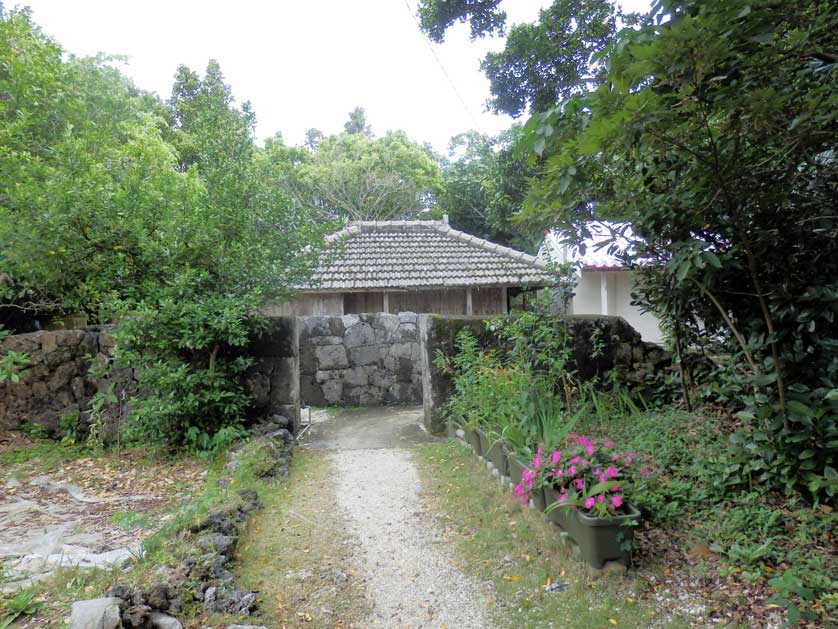
Historical residence in Tokujin Village, Okinawa
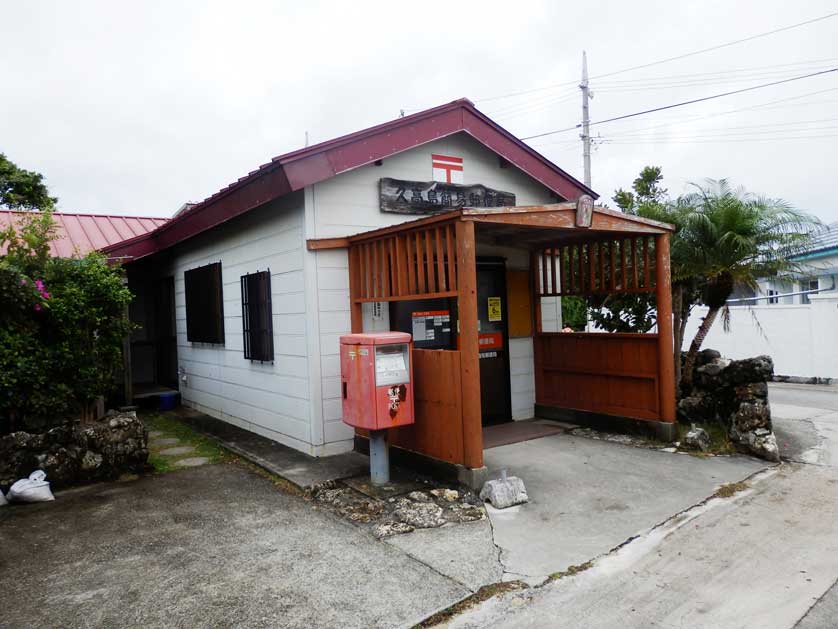
Kudaka Island Post Office
Ishikihama Beach
From the Akaribaru Michi Road between Tokujin Village and Cape Kaberu, various footpaths lead through the coastal forest to the beaches. They are partly sandy, partly rocky. They are not sunbathing / swimming beaches though. To various degrees, they are all sacred.
One of the holiest is Ishikihama Beach - and it's open to visitors. According to legend, the gods floated a golden jar ashore there, containing seven types of seeds. A young couple much in love was present when the jar reached the shore.
Making use of the seeds, they introduced agriculture to Okinawa. Today, when island tour guides lead their tour groups to the beach, they customarily pray to the ancient gods standing with their feet in the ocean water.
Further up on the island, the vegetable fields give way to a dense subtropical jungle. Poisonous habu snakes inhabit the jungle and make it dangerous to enter.
The road / bicycle path around the island is safe however. The whole island can be explored by bicycle in about 2 to three hours.
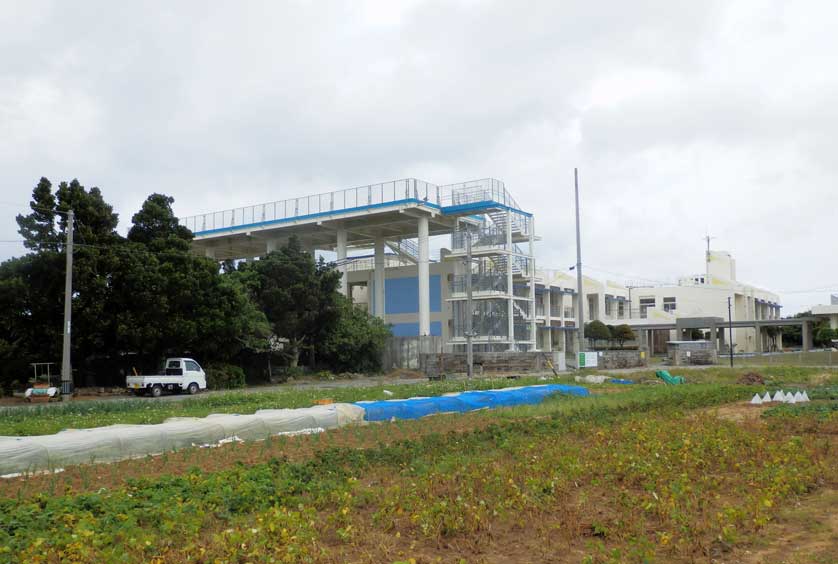
Tsunami rescue platform, Kudaka Island
Tokujin Village
Tokujin Village offers many intriguing back alleys. There are a few accessible sacred sites with small Okinawan sacred rooms which look very different from Shinto shrines or Buddhist temples, there are also a few historic residences.
The most outstanding structure of the village is a large elevated platform right next to the public school. The platform was erected shortly after the devastating Tohoku earthquake / tsunami in 2011 and is designed to provide the whole of the Kudaka population as well as the present visitors with a rescue area.
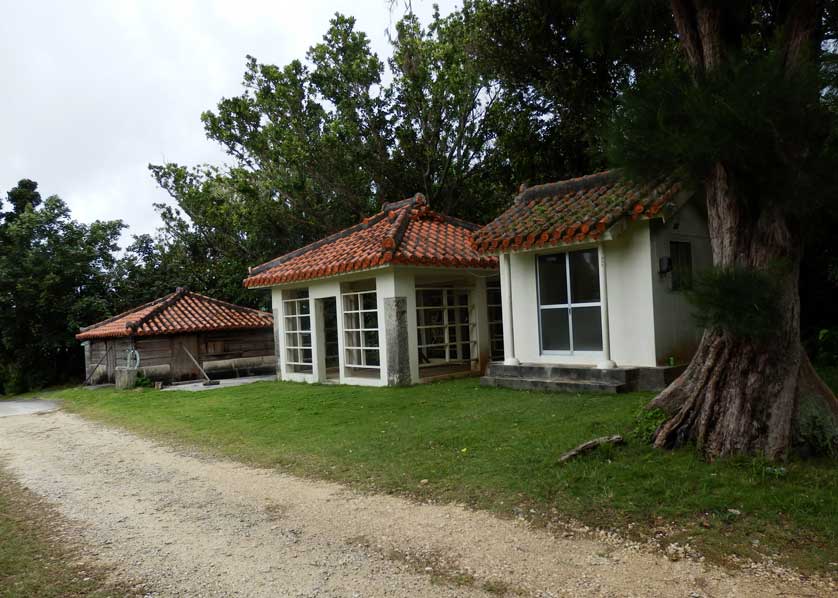
The sea snake smokehouse on the left with two traditional Okinawan sacred rooms
Kudaka Island Cuisine
The most famous dish of the island is the Irabu Sea Snake Soup. It is served at two of the three Tokujin Village restaurants, at the Shokujidokoro Tokujin and the Sabani.
All three of the Tokujin Village restaurants, including Restaurant Kei, serve dishes centered on umibudo, sea grapes, another Okinawan specialty. Sea Grapes, also known as Green Caviar, are a sort of seaweed that grows caviar-like bubbles.
Okinawan-style soba noodles are on offer as well as a variety of Okinawan fish, seafood and pork dishes.
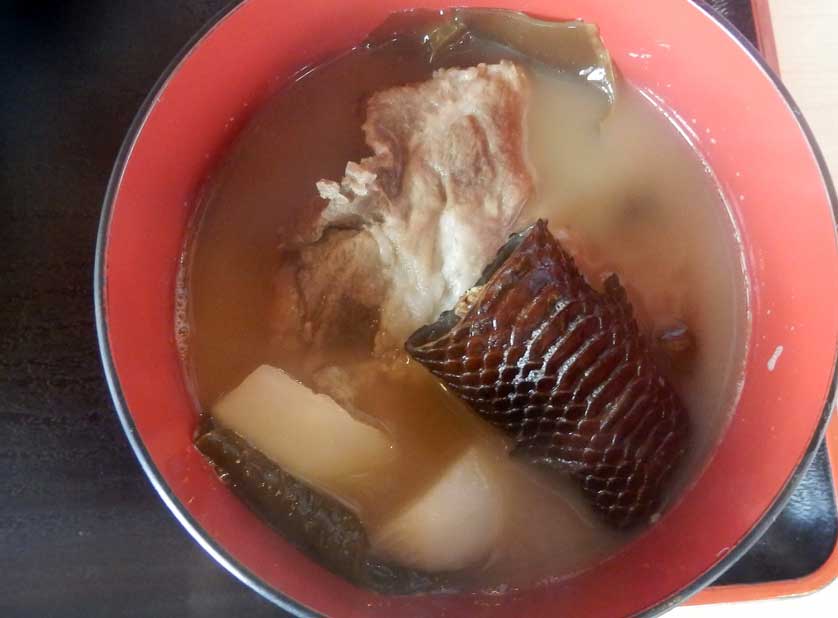
Bowl of irabu-jiru sea snake soup served at the Tokujin Restaurant
Kudaka Access
Bus from Naha
From the Naha Bus Terminal, take bus number 38 towards Shikiya, get off at Azama Sansan Beach Iriguchi.
The ride takes about one hour, the fare is 780 yen one way. You need to pay in cash on the bus on arrival. Have the exact fare ready in coins.
Azama Port is in short walking distance from the Azama Sansan Beach Iriguchi bus stop.
Kudaka Ferry
Ferry website with schedule in English www.kudakakaiun.jimdo.com/english
The fare is 1,280 yen return trip
Irabu restaurants
The Shokujidokoro Tokujin is right next to the Kudaka Visitor Center, about a 3 minute walk from Tokujin Port. Open daily from 11.30 am to 9 pm (last order at 8 pm).
Tel: 098 948 2889
The Sabani Restaurant is about a 3 minute walk from Tokujin Port on Kudaka. Open daily from 9 am to the departure of the last customer. Tel: 098 948 3893
Accommodation
There are a few small guest houses on Kudaka Island. They include the Niraiso (Tel 098 948 2292) and the Nishime (Tel 098 948 2294).
There is also a camp ground on the island.
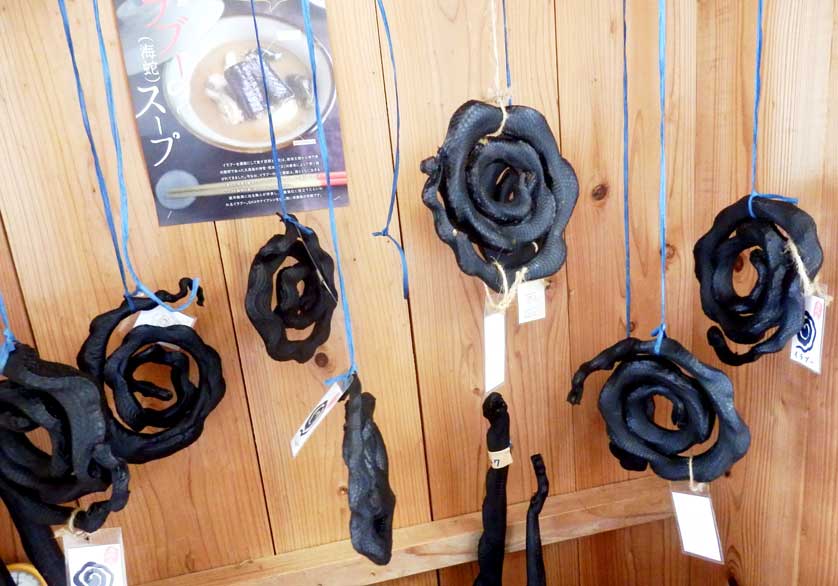
Smoked irabu sea snakes on sale, Kudaka Island, Okinawa
